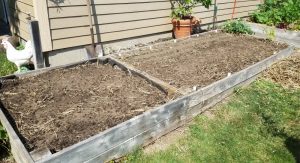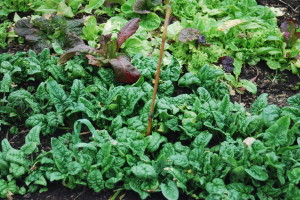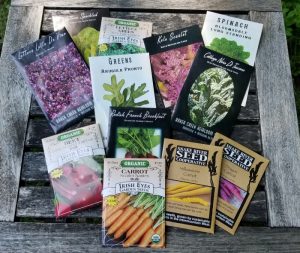It’s a fact: We have a fairly short growing season for warm-weather crops in north Idaho. But summer’s end doesn’t mean that the garden has to stop producing. On the contrary, planting a fall garden delivers fresh produce right through October, past the first frost, and with a little help from Mother Nature, mulch, and row covers, well into November!
The key to a successful fall garden is planting cool-season crops in mid-July through early August. Planting in mid-summer may sound a bit odd for cool crops, especially when temperatures are soaring to the upper 90s. But planting now provides enough time (and daylight) to get your fall crops started. They will begin to flourish as cooler temperatures prevail by summer’s end.
Here are a few fall gardening tips, as well as my favorite cool-season crops for you to consider for your vegetable garden this fall.
Prep Work

Now that the garlic has been harvested, this 12 foot bed is ready for fall planting. Soon arugula, kale, and spinach will take over.
Clear it Out. By now you probably have a few crops that are waning in production or are finished producing altogether. It’s time to clear those plants out and make way for cool-season crops. Remove any old plant debris, and pull or dig weeds.
Survey the Soil. If you added soil amendments (compost, rotted manure, soil conditioners, etc.) in the early spring, you probably won’t need to reapply these additives. However, it’s never a bad idea to add a top dressing of compost around your seedling plants.
Mulch, Mulch, Mulch! To keep weeds at bay, and more importantly, keep the soil cool and moist, apply a layer of mulch to your garden once your seeds emerge or transplants are in. Cool-season crops need cool soil, so mulching is a critical step. Chopped straw, pine needles, leaves, or grass clippings will do the job. Beware of using any mulch material that contains herbicides. Do not use “certified weed-free” straw or grass clippings from lawns treated with herbicides. The herbicide residues can effect your plants. I’ve used regular straw for years without any major incident of weeds — what usually pops up are a few stalks of wheat!
What to Plant
My first rule of thumb when it comes to what to plant is always plant what you love to eat!! The second rule is to select plant varieties that are “early” and/or have shorter “days to maturity.” This ensures a crop before winter really sets in.
My Fall Favorites
Greens: I’m a “greens” freak, so my fall garden is full of arugula, spinach, and kale (several types including lacinato, Russian red, and scarlet). These greens are fall standards, but there are many other types of greens to try. Be bold and plant mache’ (known as corn salad), or orach, with it red leaves. All these greens are wonderful in fall salads or sauteed as a side dish.
Lettuces: Lettuce loves cooler temperatures and will turn bitter and bolt in summer’s heat. Now’s a great time to reseed your lettuce plot. I always go for the loose-leaf, cut-and-come-again varieties, like ‘Speckled’ lettuce (45 days) and ‘Bronze Beauty’ (45 days). There are many early varieties to choose from. One of the best lettuces to grow in fall is endive!
Root Crops: Root crops like radishes, beets, and carrots can also be started now. Because most radishes mature around 30 days, you can do a succession planting every week and have radishes right through the fall. Or try a more unusual variety like the watermelon radish, which grows best when planted for a fall harvest. Tender beet greens will be a nice complement to a fall salad, along with baby beets. My favorite beet is ‘Early Wonder’, with 50 days to maturity. Carrots typically take a little longer to mature (60 to 70 days), but can overwinter in the ground when properly mulched. It’s a joy to trundle out to the garden in November to dig fresh carrots for Thanksgiving dinner.
Herbs: Did your cilantro seem to go from seedling to seed this summer? Well, try again now. Cilantro actually does best with cooler temperatures, and you’ll have a crop just in time for making salsa!
It can be difficult to find seed in the garden centers this time of year — especially if you want to try something a little out of the ordinary, so below are links to my favorite seed companies:
Snake River Seed Company
Baker Creek Heirloom Seeds
Seed Savers Exchange
Planting a fall garden of hardy, cool-weather crops helps extend our already short growing season. Many of these plants will survive the first couple of frosts and some, like kale and spinach, actually taste better after a frost.
Low-tunnels can help extend the season right through winter and into spring. Here at the 2nd Street Chicken Ranch, we often get an early spring harvest of spinach from the crop planted the previous fall.
With a little planning and prep work, you can still enjoy the bounty of your garden well in to fall!
Happy Gardening!




Leave a Reply